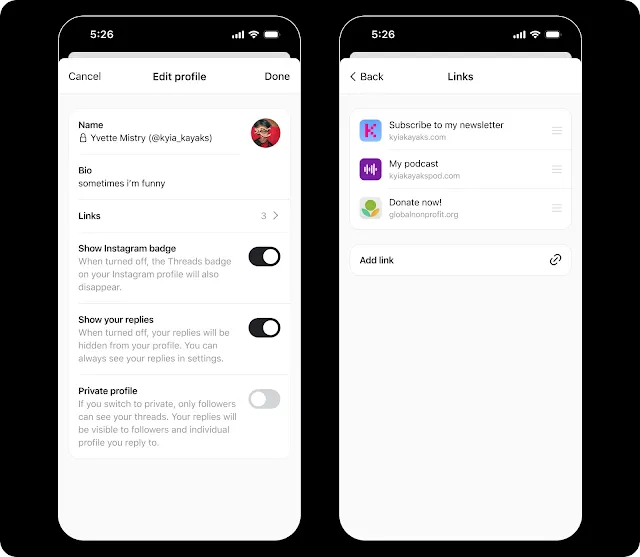For users posting on Threads — especially digital creators, media professionals, and online publishers — links have long felt like an afterthought. Posts containing URLs often struggled to find traction in the app’s recommendation engine, leaving many to wonder whether external content was being subtly discouraged.
This wasn’t entirely speculative. Instagram and Threads executive Adam Mosseri has openly acknowledged that links aren’t a priority in the platform’s content ranking process. While he stopped short of calling it intentional suppression, the outcome remained the same: posts with links tended to fade into the background.
That’s beginning to shift.
Meta, now pivoting harder toward creators as a cornerstone of Threads’ growth, is starting to adjust how links function on the platform. One of the more visible changes is a new option allowing users to embed up to five links directly within their bio — offering more flexibility than the previous single-link constraint.
More consequential, though, is how the app is starting to treat links in posts. Rather than fading out, posts that contain URLs are now being included more frequently in the app’s recommendations. And to make that visibility measurable, Meta has introduced new link-specific analytics that show creators how their audience engages with shared content — including how many taps a given link receives.
Meta, in a recent update, emphasized that the goal is to help creators expand their reach, even beyond the confines of the Threads platform itself.
While this may be welcome news for those hoping to convert their Threads presence into tangible traffic, questions remain. The recommendation engine still operates with limited transparency, and even high-follower accounts often see more reach from suggested posts than from their own followers. That dynamic makes the algorithm’s behavior harder to predict — especially when the performance of link-based content is on the line.
Media organizations and independent publishers, in particular, have reported inconsistent outcomes. A very small set of big publishers saw more reliable referral traffic from new networks like Bluesky, which despite its size, delivered steadier results. However, a recent uptick in link-driven engagement on Threads has been observed — especially after Meta rolled back its previous stance on promoting political content.
That said, caution remains warranted. Meta’s history is marked by frequent strategic pivots that have, in the past, disrupted the ecosystems of creators and publishers. Even so, with the platform loosening its grip on link visibility and engagement, there may be an emerging window for experimentation — one that could be worth exploring for anyone seeking new channels of audience growth.
Read next:
• Privacy Group Noyb Challenges Meta’s AI Training Plans Citing GDPR Violations
• ChatGPT Usage Statistics: Numbers Behind Its Worldwide Growth and Reach
This wasn’t entirely speculative. Instagram and Threads executive Adam Mosseri has openly acknowledged that links aren’t a priority in the platform’s content ranking process. While he stopped short of calling it intentional suppression, the outcome remained the same: posts with links tended to fade into the background.
That’s beginning to shift.
Meta, now pivoting harder toward creators as a cornerstone of Threads’ growth, is starting to adjust how links function on the platform. One of the more visible changes is a new option allowing users to embed up to five links directly within their bio — offering more flexibility than the previous single-link constraint.
More consequential, though, is how the app is starting to treat links in posts. Rather than fading out, posts that contain URLs are now being included more frequently in the app’s recommendations. And to make that visibility measurable, Meta has introduced new link-specific analytics that show creators how their audience engages with shared content — including how many taps a given link receives.
Meta, in a recent update, emphasized that the goal is to help creators expand their reach, even beyond the confines of the Threads platform itself.
While this may be welcome news for those hoping to convert their Threads presence into tangible traffic, questions remain. The recommendation engine still operates with limited transparency, and even high-follower accounts often see more reach from suggested posts than from their own followers. That dynamic makes the algorithm’s behavior harder to predict — especially when the performance of link-based content is on the line.
Media organizations and independent publishers, in particular, have reported inconsistent outcomes. A very small set of big publishers saw more reliable referral traffic from new networks like Bluesky, which despite its size, delivered steadier results. However, a recent uptick in link-driven engagement on Threads has been observed — especially after Meta rolled back its previous stance on promoting political content.
That said, caution remains warranted. Meta’s history is marked by frequent strategic pivots that have, in the past, disrupted the ecosystems of creators and publishers. Even so, with the platform loosening its grip on link visibility and engagement, there may be an emerging window for experimentation — one that could be worth exploring for anyone seeking new channels of audience growth.
Read next:
• Privacy Group Noyb Challenges Meta’s AI Training Plans Citing GDPR Violations
• ChatGPT Usage Statistics: Numbers Behind Its Worldwide Growth and Reach


